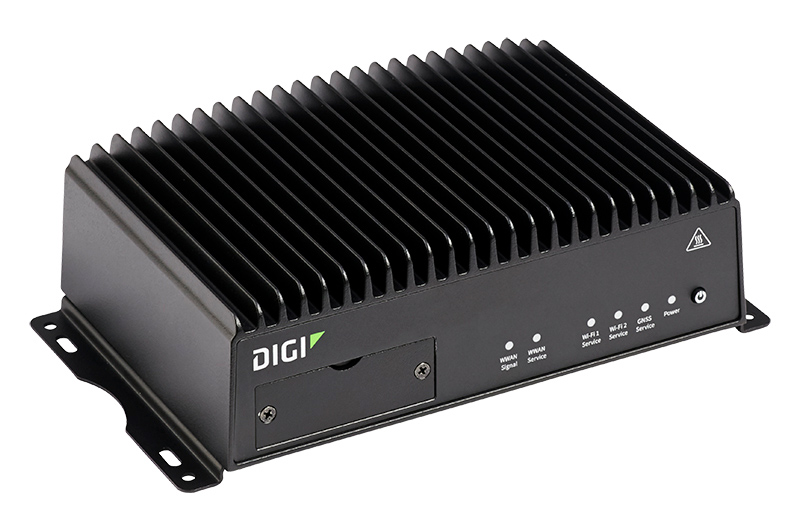Modern transit systems incorporate cellular routers, which enable connection to a private network or the internet through packet data network gateways identified by their access point name (APN) technology to support communications for multiple purposes. The methods built into the router to facilitate both public and private communication via APN are important to understand, as they have implications for your transit agency's cost of doing business.
In this post we will cover these key considerations, and share how Digi has solved this challenge to assist transit agencies in simplifying their systems, improving security, and lowering cost.
Transit Systems: Communications Technology at Work
Not so many years ago, public transit agencies mostly had to concern themselves with moving people from point A to point B. Now, in addition to moving people, these organizations need to be concerned with moving an ever-increasing quantity of data wirelessly.
Most transit vehicles today produce two distinct data streams: vehicle data and passenger data. The vehicle data stream pertains to the operation of the bus or rail vehicle itself, including automated passenger counting (APC), fare collection and CAD/AVL data (Computer Aided Dispatch/ Automated Vehicle Location), as well as data pertaining to the performance of the engine and other mechanical systems. The second data stream is passenger Wi-Fi, a popular amenity that many transit agencies provide for their riders, free of charge.
Data Backhaul Considerations
An important issue in transit operations is the question of when to transmit the data for optimal efficiency and reduced cost.
- Some vehicle operations systems such as fare collection require real-time communications, so they make use of cellular networks for data transmission.
- Passenger Wi-Fi of course requires real-time data transmission over cellular, albeit at a lower priority than vehicle data.
- Other vehicle operations systems such as video security and vehicle maintenance generate a tremendous amount of data which is generally not required in real time. It can be downloaded when the vehicle enters a depot or station at the end of the day and transmitted through Wi-Fi, which, of course, is much less expensive than cellular, especially for large data files.
Separating Public and Private Data
It’s very important to keep these two data streams separate, primarily for security reasons. This has typically resulted in the deployment of two independent cellular routers and two antennas on the roof of the vehicle. Another alternative has been the installation of a cellular router with optional second field upgradeable modem, to enable passenger Wi-Fi deployment at some future date. However there is a lower cost alternative that provides the required performance and functionality at first installation without a future field upgrade. This is where dual APN technology comes in.
Public and Private APN in One Router
 Every cellular device communicates with a particular packet data network gateway, uniquely identified by its access point name (APN). There are both public and private APNs. Vehicle data is typically assigned to a private APN to be secure from hackers and is run through an IPsec VPN. Now, however, the leading cellular operators are offering a split tunnel, also known as dual APN functionality where, in a single physical interface, a cellular router can conduct two separate data sessions simultaneously, using a single wireless connection. A device with this capability can route data traffic for passenger Wi-Fi to a public gateway, allowing transit passengers to access the Internet. Meanwhile, data traffic for vehicle operations is routed to the transit organization’s private network gateway.
Every cellular device communicates with a particular packet data network gateway, uniquely identified by its access point name (APN). There are both public and private APNs. Vehicle data is typically assigned to a private APN to be secure from hackers and is run through an IPsec VPN. Now, however, the leading cellular operators are offering a split tunnel, also known as dual APN functionality where, in a single physical interface, a cellular router can conduct two separate data sessions simultaneously, using a single wireless connection. A device with this capability can route data traffic for passenger Wi-Fi to a public gateway, allowing transit passengers to access the Internet. Meanwhile, data traffic for vehicle operations is routed to the transit organization’s private network gateway.
Dual APN offers a way to reduce the chaos – and cost – of maintaining different equipment for different purposes. Transit agencies will sometimes install a separate router offered by a fare collection system integrator to handle that part of their data traffic. Increasingly though, transit agencies are choosing to make onboard cellular routers an extension of their own internal IT infrastructure in order to streamline operations and reduce equipment and service costs.
Digi offers a particular model of the TX54 purpose-built to take advantage of dual APN technology to support all required backhaul methods, data types and priorities. It is the TX54-A112, which has two independent and concurrent Wi-Fi interfaces and a single cellular interface. With this capability, a transit agency can save the cost of a second cellular router and a second antenna. Yet even with this enhanced functionality, the Digi TX54 is a relatively low cost router, making it a great option for budget constrained transit agencies. Frankly, there isn’t another product on the market that has this particular feature set. While a few other products offer dual APN, they don't have the dual Wi-Fi capability that Digi provides on the TX54-A112. (The Digi TX64, which is also capable of dual APN, offers additional features at a slightly higher price point.)

It’s important to mention that, like all of the latest Digi routers, the TX54 can be monitored and have its firmware updated remotely using Digi Remote Manager®. This solution enables a router administrator to track the status and performance of each individual router while retaining the ability to perform mass upgrades.
Transportation Routers for the Rigors of Transit Environments
The “T” in TX54 stands for transportation. Transportation routers must be capable of being mounted on a vehicle and powered directly by the vehicle’s electrical system.
In addition to being durable enough to withstand the vibration and temperature swings of an outdoor environment, a transportation router has to be especially quiet, so it doesn’t disturb other on-board electronics. It also has to be able to accept high noise, such as from the 100-volt spikes that can come off the engine alternator. The Digi TX54 meets all of these requirements.
Advertisers Stepping Up to Fund Passenger Wi-Fi
Transit agencies are always looking for ways to get more people onto their buses and trains and one of the most common ways to do that is to provide an enhanced on-board experience, including offering passenger Wi-Fi. Even in a budget-tightening phase, dual APN with the Digi TX54 is a fast, simple and low cost way to add this feature to a transit system.
If passenger Wi-Fi isn’t in the budget at present, a transit agency could choose the Digi TX54 (or Digi TX64) and install the hardware, which is needed for vehicle operations anyway, and gain the option of adding passenger Wi-Fi sometime in the future – without incurring the expense of switching out routers or adding a second modem and antenna. For those transit systems that already have passenger Wi-Fi, the TX54 is a reliable, low-cost way to upgrade when the time comes.
Plan Now for Brighter Days Ahead
Managing mass transit is complex, and it's important to find a balance between keeping fares as low as possible with the need to provide amenities that attract more passengers. Digi TX54 offers a way to provide the necessary functionality that a vehicle’s onboard systems need, along with the ability to support passenger Wi-Fi now or in the future.
If your transit system is approaching its next round of upgrades, or you’re simply looking for ways to provide better service at a lower cost, then the Digi TX54 could be the solution for you.
To learn more, visit the Digi TX54 product page.